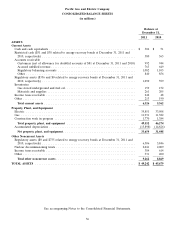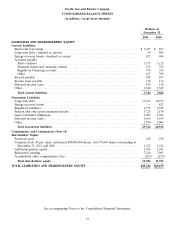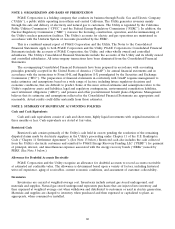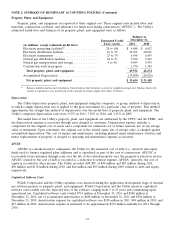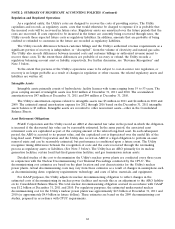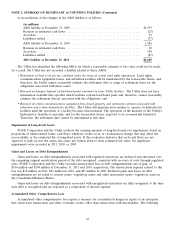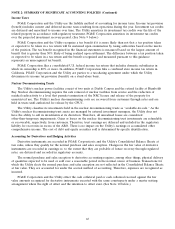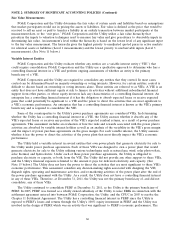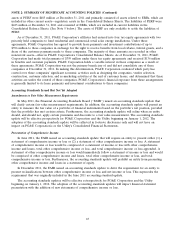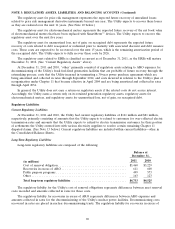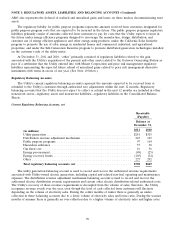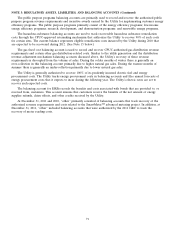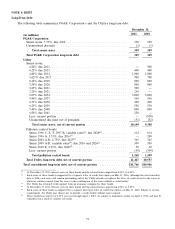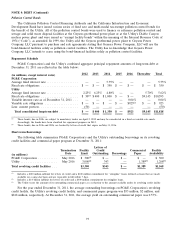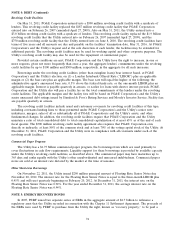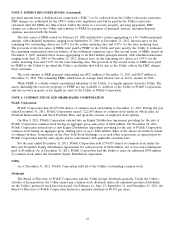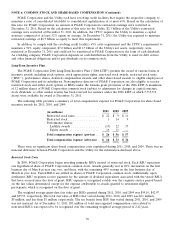PG&E 2011 Annual Report Download - page 70
Download and view the complete annual report
Please find page 70 of the 2011 PG&E annual report below. You can navigate through the pages in the report by either clicking on the pages listed below, or by using the keyword search tool below to find specific information within the annual report.NOTE 2: SUMMARY OF SIGNIFICANT ACCOUNTING POLICIES (Continued)
Fair Value Measurements
PG&E Corporation and the Utility determine the fair value of certain assets and liabilities based on assumptions
that market participants would use in pricing the assets or liabilities. Fair value is defined as the price that would be
received to sell an asset or paid to transfer a liability in an orderly transaction between market participants at the
measurement date, or the ‘‘exit price.’’ PG&E Corporation and the Utility utilize a fair value hierarchy that
prioritizes the inputs to valuation techniques used to measure fair value and give precedence to observable inputs in
determining fair value. An instrument’s level within the hierarchy is based on the lowest level of any significant input
to the fair value measurement. The hierarchy gives the highest priority to unadjusted quoted prices in active markets
for identical assets or liabilities (Level 1 measurements) and the lowest priority to unobservable inputs (Level 3
measurements). (See Note 11 below.)
Variable Interest Entities
PG&E Corporation and the Utility evaluate whether any entities are a variable interest entity (‘‘VIE’’) that
could require consolidation. PG&E Corporation and the Utility use a qualitative approach to determine who has a
controlling financial interest in a VIE and perform ongoing assessments of whether an entity is the primary
beneficiary of a VIE.
PG&E Corporation and the Utility are required to consolidate any entities that they control. In most cases,
control can be determined based on majority ownership or voting interests. However, for certain entities, control is
difficult to discern based on ownership or voting interests alone. These entities are referred to as VIEs. A VIE is an
entity that does not have sufficient equity at risk to finance its activities without additional subordinated financial
support from other parties, or whose equity investors lack any characteristics of a controlling financial interest. An
enterprise has a controlling financial interest if it has the obligation to absorb expected losses or receive expected
gains that could potentially be significant to a VIE and the power to direct the activities that are most significant to
a VIE’s economic performance. An enterprise that has a controlling financial interest is known as the VIE’s primary
beneficiary and is required to consolidate the VIE.
Some of the counterparties to the Utility’s power purchase agreements are considered VIEs. In determining
whether the Utility has a controlling financial interest in a VIE, the Utility assesses whether it absorbs any of the
VIE’s expected losses or receives any portion of the VIE’s expected residual returns, as a result of power purchase
agreements. This assessment includes an evaluation of how the risks and rewards associated with the power plant’s
activities are absorbed by variable interest holders as well as an analysis of the variability in the VIE’s gross margin
and the impact of power purchase agreements on the gross margin. For each variable interest, the Utility assesses
whether it has the power to direct the activities of the power plant that most directly impact the VIE’s economic
performance.
The Utility held a variable interest in several entities that own power plants that generate electricity for sale to
the Utility under power purchase agreements. Each of these VIEs was designed to own a power plant that would
generate electricity for sale to the Utility utilizing various technologies such as natural gas, wind, solar photovoltaic,
solar thermal, and hydroelectric. Under each of these power purchase agreements, the Utility is obligated to
purchase electricity or capacity, or both, from the VIE. The Utility did not provide any other support to these VIEs,
and the Utility’s financial exposure is limited to the amount it pays for delivered electricity and capacity. (See
Note 15 below.) The Utility does not have the power to direct the activities that are most significant to these VIE’s
economic performance. This assessment considers any decision-making rights associated with designing the VIE,
dispatch rights, operating and maintenance activities, and re-marketing activities of the power plant after the end of
the power purchase agreement with the Utility. As a result, the Utility does not have a controlling financial interest
in any of these VIEs. Therefore, at December 31, 2011, the Utility was not the primary beneficiary of, and did not
consolidate, any of these VIEs.
The Utility continued to consolidate PERF at December 31, 2011, as the Utility is the primary beneficiary of
PERF. In 2005, PERF was formed as a wholly owned subsidiary of the Utility to issue ERBs in connection with the
settlement agreement entered into between PG&E Corporation, the Utility, and the CPUC in 2003 to resolve the
Chapter 11 Settlement Agreement. The Utility has a controlling financial interest in PERF since the Utility is
exposed to PERF’s losses and returns through the Utility’s 100% equity investment in PERF and the Utility was
involved in the design of PERF, which was an activity that was significant to PERF’s economic performance. The
66


